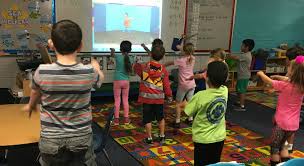A Little Bit About Me
My name is Olivia Howse, I am a Physical and Health Education major and English minor in my second year here at UVic. My educational journey has been influenced by attending three different high-schools growing up. Each had their pros and cons, ultimately shaping the person I am now.
Understanding Active Health Education
Health education plays a crucial role in shaping a person’s attitude toward physical activity, particularly when introduced at a young age. The foundation for these beliefs and behaviours is established early, and experiences with physical activity during childhood can have a lasting effect on an individual’s relationship with exercise throughout their lifetime. If children develop a positive and engaged view of physical activity in their early years, they are more likely to maintain those healthy habits as they grow older.

Therefore, it is essential for educators to understand the significance of health education and the role they play in shaping these lifelong habits. Educators serve as key figures in conveying what is considered good physical literacy, what habits are beneficial, and which activities should be avoided. By being proactive in their teaching, educators can ensure that young people develop the knowledge and skills to make healthy choices throughout their lives.
Key Issues in Youth Physical Activity
In many schools, youth physical activity often revolves around playing games, but this approach is sometimes ineffective in fostering genuine engagement with physical activity. A major concern is that not all students possess the same level of skill or understanding when it comes to performing the necessary movements required to participate in sports or physical activities. In such cases, the lack of appropriate instruction or differentiation in teaching can create disengagement among students. For instance, if an educator assumes that all students are beginners and teaches the most basic skills in a basketball class, students who are already familiar with the sport may quickly become bored and uninterested. This can lead to them opting out of participation altogether, even though they have the skills needed to engage more deeply with the activity.

Therefore, it is vital that educators tailor their instruction to the varied skill levels of their students. Active instruction should take place, with differentiated attention based on students’ existing knowledge and abilities. In doing so, students who are more advanced are challenged and kept engaged, while beginners receive the support they need to improve. Effective teaching in physical education also requires consistent checks for understanding and maintaining student attention. Young people can easily become distracted, especially when they are not being actively engaged or when the material feels too basic. A captivating delivery of instructions, one that incorporates both clear communication and dynamic engagement, can maximise the limited time available in physical education classes. This approach encourages active participation, making the most out of every opportunity for movement and skill development.
The Role of Sedentary Behaviour in Youth Health

A significant challenge facing today’s youth is the growing prevalence of sedentary behaviour, which is increasingly recognised as a major contributor to various health issues. In the article Targeting Reductions in Sitting Time to Increase Physical Activity and Improve Health, the authors, argue that current research and public health initiatives have been disproportionately focused on encouraging moderate-to-vigorous physical activity. They propose that shifting the focus toward reducing sedentary behaviour could be a highly effective strategy for improving overall health, as it would create a behavioural leverage point capable of bringing about significant positive health changes across populations.
The authors raise an important question: Why has there been such a heavy emphasis on increasing moderate-to-vigorous intensity activity, while so little attention has been paid to reducing sedentary behaviour or encouraging lighter physical activity? The article presents a quantitative study that collected data on sedentary time, examining how long students spent sitting versus being physically active throughout the day. The results indicated that, on average, students exhibited higher levels of sedentary behaviour during the middle part of the week (Tuesday to Thursday), compared to the beginning and end of the week (Friday to Monday). The study also explored the circumstances and contexts in which sedentary activity took place, providing insight into how simple adjustments could be made to reduce overall sitting time.
One key finding across the studies examined in the article is that individuals who are generally less active tend to benefit the most from substituting sedentary behaviour with light or moderate-to-vigorous physical activity. Furthermore, prospective reductions in sedentary time have been linked with lower risks of mortality and disease, highlighting the importance of interventions that promote more active lifestyles. Physiological and cardio-metabolic benefits associated with breaking up prolonged sitting time provide compelling biological support for these findings. The research has informed workplace interventions aimed at increasing the number of daily breaks from sitting, and similar strategies could be applied in school settings to help young people reduce sedentary time. (KEADLE et al., 2017).

To address this issue in schools, educators can incorporate purposeful breaks during the day to encourage physical activity. For example, active fitness videos can be integrated into the classroom, especially for younger grades. These videos, which often combine movement with educational content like spelling and math, can provide a fun and engaging way to break up long periods of sitting. By using such videos, teachers can offer students a physical break while simultaneously giving themselves a brief respite from lecturing. This not only contributes to better overall health for students but also enhances their focus and productivity in the classroom.
Article refered to:
Keadle SK, Conroy DE, Buman MP, Dunstan DW, Matthews CE. Targeting Reductions in Sitting Time to Increase Physical Activity and Improve Health. Med Sci Sports Exerc. 2017 Aug;49(8):1572-1582. doi: 10.1249/MSS.0000000000001257. PMID: 28272267; PMCID: PMC5511092)
5-Step Model For Active Health
One way to systematically approach active health education is through the use of a structured model that outlines key stages for creating effective programs. The following 5-step model can guide educators in developing and refining their strategies to promote active health:
A – Agree: The first step is to assess the current situation. This involves understanding the existing level of engagement with physical activity, identifying the role of educators, and evaluating current program offerings. This stage allows educators to establish a baseline from which they can measure progress.
B – Build: The next step is to lay the foundation for the program. This includes identifying key stakeholders such as other teachers, administrators, and parents, and sharing the vision for promoting physical activity. Building a strong support system is essential for the success of any health initiative.
C – Clarify: Establishing a common understanding is crucial for ensuring that all involved parties are on the same page. This involves communicating the core concepts, methods, and goals of the program, as well as sharing a vision statement and informing key partners about their roles.
D – Define: In this stage, educators set clear objectives and plans. This includes identifying specific goals for the program, organising responsibilities, creating action plans, and setting priorities for implementation. Defining these elements helps ensure that the program is focused and actionable.
E – Evaluate: Finally, educators must assess the effectiveness of the program. This involves reviewing whether the objectives have been met, evaluating the impact of the program, and learning from both successes and challenges. The evaluation process provides valuable insights that can inform future efforts to improve physical activity education. (Hotchins, 2025)
By following these steps, educators can design and implement comprehensive health education programs that encourage active living and help students develop the skills and mindset needed for lifelong health and well-being.
Developing Health Competencies in Students

An essential aspect of health education is the development of health competencies in students, which refers to the knowledge, skills, and attitudes needed to make informed decisions about health and well-being. Developing these competencies empowers students to take ownership of their health, understand the benefits of regular physical activity, and make healthy lifestyle choices both in and outside of the school environment. Health competencies go beyond just physical fitness; they include understanding the importance of balanced nutrition, mental and emotional health, and the impact of behaviours such as sleep and stress management.
Educators can foster these competencies by providing students with a well-rounded curriculum that integrates practical skills alongside physical activities; goal-setting, self-monitoring, and stress-reduction techniques. This approach helps students develop a deeper understanding of how their daily choices influence their long-term health, and it encourages them to take proactive steps toward maintaining a healthy lifestyle. By cultivating these competencies, schools can play a pivotal role in shaping resilient, health-conscious individuals who are prepared to navigate the challenges of adulthood with the tools they need to thrive.
Leave a Reply